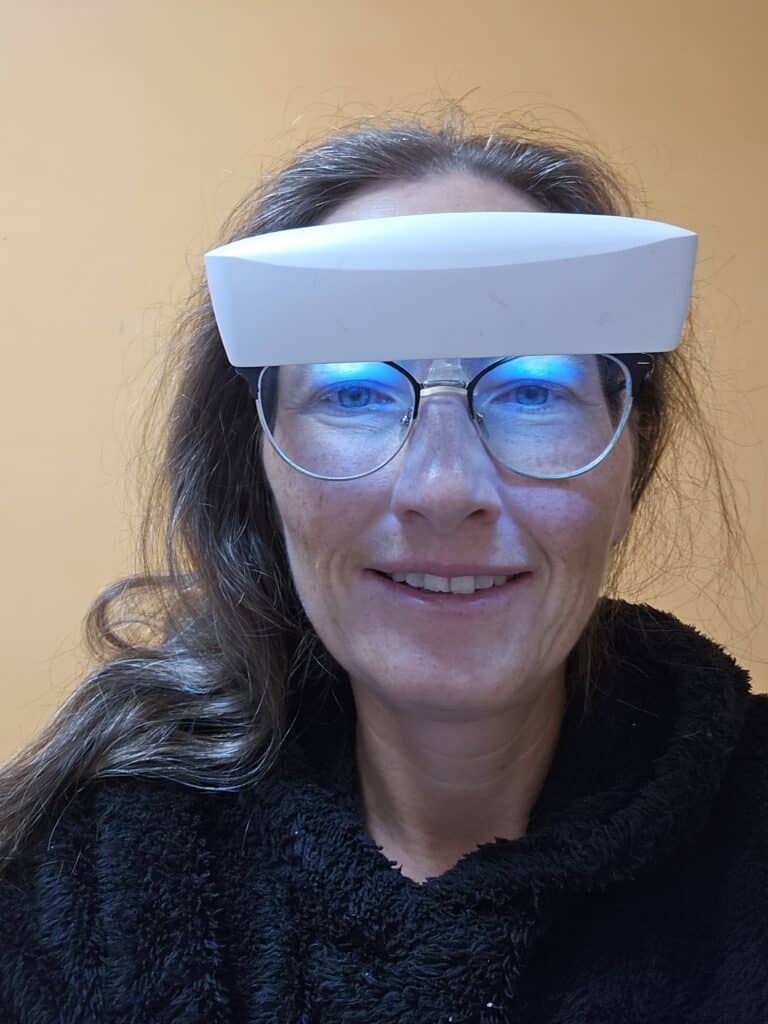Every year, when autumn approaches, I’m watching every day of the summer that goes by, and I’m afraid. I feel like I’m slowly moving towards a deep, dark hole that I won’t be able to crawl from for half a year. That I will not really be alive during that time.
This time every year, I feel like I’m dying a little bit.
Then the winter comes, my mood and energy levels fall, and I feel like I’m crawling during the gray, gray days. My motivation and willpower disappear down the drain. I can’t seem to do anything productive. Instead, I just lie down and read or endlessly scroll Facebook. I count the days until the return of spring.
Many of you probably know this battle. But while winter blues SUCK, there are ways to make this time of the year at least a little easier.
Disclaimer: This blog is based on personal experience and is not medical advice. Always consult a qualified healthcare professional before making changes to your health, treatment, or medications.
There are several affiliate links in this article. If you buy anything through them, you help to support this blog and will have my undying gratitude, and it doesn’t cost you anything extra!
What is seasonal affective disorder?
Seasonal affective disorder, commonly abbreviated as SAD, is a type of depression that follows a seasonal pattern. Typically, it comes during the fall and winter months when daylight hours are shorter, but it can also affect some people in the spring and summer.
It’s also known as “seasonal depression” or “winter depression,” and it’s recognized as a legitimate mental health condition. SAD is more than just feeling down. It messes with our work, our relationships, and our daily lives. It’s important to understand that seasonal affective disorder is a real medical condition that requires attention and treatment.
What causes seasonal affective disorder?
The exact cause of SAD isn’t fully understood yet, but researchers believe it’s caused by a combination of factors.
Fewer hours of sunshine certainly play their role. Shorter days can disrupt your body’s internal clock, which regulates sleep and mood. Sunshine helps your brain to create serotonin, and in winter, you have less of this neurotransmitter that is necessary to feel happiness.
The changing seasons can impact the production of melatonin in your body. Melatonin is a hormone that signals to your body that it’s time to sleep. Its production increases in response to darkness. When your body produces more of this hormone during the darker months, you feel more lethargic and can have problems with sleeping too much.
Also, a deficiency in vitamin D probably plays a role. This is a vitamin that our body produces when it’s exposed to sunlight. Vitamin D is involved in the production of serotonin, a neurotransmitter that regulates mood. When you don’t have enough of it, you feel depressed and lethargic.
And last but not least, genetic factors can contribute to the winter blues. If your family has a history of depression, you are more likely to develop SAD.
Seasonal affective disorder symptoms
SAD symptoms can vary in severity, but they often mirror those of major depression. Common symptoms include:
- Persistent feelings of sadness, hopelessness, or emptiness
- Low energy or fatigue
- Difficulty concentrating
- Increased sleep (hypersomnia)
- Loss of interest in activities you once enjoyed
- Changes in appetite or weight (often craving carbohydrates and weight gain)
- Feelings of worthlessness or guilt
- Irritability or agitation
- Physical symptoms like headaches or body aches
- Social withdrawal, often referred to as “hibernating”
For those with spring/summer SAD, symptoms include insomnia, weight loss, restlessness, and anxiety.
Is seasonal affective disorder real?
Yes, Seasonal affective disorder is real and recognized by mental health professionals as a subset of depression. It’s listed in the Diagnostic and Statistical Manual of Mental Disorders (DSM-5) under major depressive disorder with seasonal pattern. Research supports its legitimacy and shows links between SAD and changes in exposure to natural light, brain chemistry, and biological rhythms.
Seasonal affective disorder treatment
Treating seasonal affective disorder is all about finding what works best for you. It’s often a blend of approaches: basking in the glow of a light therapy box to mimic the sunlight your body craves, stepping outside for some fresh air and vitamin D (even if it’s just a quick walk), or turning to therapy like CBT to reframe those winter blues. For some, medication or supplements like vitamin D are game-changers because they help to balance the brain chemistry that can go haywire when the sun hides. The key is to listen to your body and mind, experiment with different tools, and know that feeling better is possible with the right mix of care and support.
Seasonal affective disorder and light therapy
A lot of people find relief from seasonal depression thanks to bright light therapy. You sit in front of a special lamp that simulates sunlight every morning for 30 – 60 minutes. The bright light encourages your brain to create less melatonin, the hormone that makes you sleepy and tired, and to produce more serotonin, which improves your mood instead.
Light therapy has some advantages over antidepressants: For those who respond to it well, depression symptoms begin to improve within a week, while with antidepressants, you have to wait several weeks to see an effect. Light therapy for SAD also has very few side effects. They can include eye strain or headaches, but they are uncommon and mild.
Bright light therapy can be a good alternative to antidepressants for those who are pregnant. It can also help elderly people with limited mobility who often spend most of their time in dim environments.
It can be contraindicated in some cases, though. If you have bipolar disorder, light therapy may cause manic symptoms, especially if you increase exposure too fast or use it for too long. If you have or had eye problems like glaucoma, cataracts, or eye damage due to diabetes, you should consult with your doctor about using light therapy.
How to use a light therapy box?
Typically, you should use your lightbox within the first hour of waking up in the morning, usually for 20-30 minutes. You should sit with it 40 – 60 centimeters (16- 24 inches) from your face with your eyes open, but not looking directly into the light. (For the distance, follow the instructions for your specific light box.) You can read, watch television, do crafts, or work on a computer during the therapy.
How to choose a light therapy box?
Light boxes are designed to deliver a therapeutic dose of bright light. In general, they all do the same thing, but some types may work for you better than others. So what should you look for when choosing a light therapy box? The most important criterion is that it should provide exposure to 10,000 lux of light while producing as little UV light as possible. You should look for light therapy lamps specifically designed to help with seasonal affective disorder. Some light boxes also include features designed to protect the eyes. Give some thought to the placement of the lamp and what you might do during its use.
I use a Beurer lamp (specifically a Beurer TL41) because that’s what was readily available in my country when I needed it, but a cheaper Verilux HappyLight should help you just as efficiently. I also use the Luminette glasses that deliver the bright light directly into your eyes. They provide a slightly different feeling than a lightbox. I find that when using them, I’m more motivated, but a lightbox helps my mood a little bit more. Their advantage is that they are very portable, and in a well-lit room, you can safely move around and continue your morning preparations while wearing them. They can also help with jet lag.

Dawn simulators
Dawn simulators are alarm clocks with a light that mimics the gradual increase of natural sunlight in the morning. They use a specialized light that gradually brightens over a set period (typically 15-90 minutes) before your desired wake-up time. The light transitions from a dim, warm glow to a bright, daylight-like intensity. It is usually placed on a bedside table where its light can shine directly toward your eyes while you sleep.
This simulated sunrise helps you wake up naturally and regulates your production of melatonin and serotonin, which improves mood and reduces symptoms of depression. Regular use of a dawn simulator can improve sleep by helping your body align more closely with a natural day-night cycle.
Pick a dawn simulator with full-spectrum light that allows you to adjust the duration and intensity of the sunrise effect according to your personal preferences. Look for a model that reaches a maximum brightness of at least 200-300 lux. Some dawn simulators have optional nature sounds, white noise, or FM radios. You will get the best results if you use the dawn simulator every morning at the same time.
You can get a cheap dawn simulator with good reviews here. If you are looking for a great quality, you can go for a Philips SmartSleep Wake-up Light.
Seasonal affective disorder and Vitamin D
Serotonin, which contributes to good mood and helps regulate sleep patterns, is dependent on vitamin D. A lot of people with seasonal affective disorder have vitamin D deficiency. This can be worse in the winter since vitamin D is produced when your skin is exposed to ultraviolet B rays from the sun. During the dark winter days, you may not have enough of this important vitamin.
Some studies suggest that supplementing with vitamin D can improve depressive symptoms if you don’t have enough of this vitamin. Supplementation of vitamin D may be most effective when combined with other treatments like light therapy. A simple blood test can measure your vitamin D levels. You need to supplement vitamin D if your levels are below 20 ng/mL.
You may need to supplement vitamin D if you spend a lot of time indoors or if you have darker skin. Increased melanin in your skin reduces your ability to produce vitamin D. Older people will benefit from the supplementation as well because aging skin synthesizes vitamin D less efficiently. Conditions like Crohn’s disease, celiac disease, or obesity can impair vitamin D absorption.
How much vitamin D should you take for seasonal affective disorder? The recommended dose for vitamin D deficiency starts at 1000 IU (international units), but one study found that women who took a dose of 5,000 IU (international units) of vitamin D per day during winter had significantly reduced symptoms of SAD. You can get an extra-strength vitamin D in that dose here. You should consult your doctor before starting high-dose supplementation.
Medication
Antidepressants help regulate mood by affecting neurotransmitters like serotonin, which are often dysregulated in SAD. Particularly, selective serotonin reuptake inhibitors (SSRIs), can be effective for treating SAD. SSRIs increase serotonin levels in the brain, which can improve mood and energy levels.
Other antidepressants include serotonin-norepinephrine reuptake inhibitors (SNRIs,) which target both serotonin and norepinephrine. They provide an alternative for those who don’t respond well to SSRIs.
Norepinephrine-dopamine reuptake inhibitors (NDRI) target norepinephrine and dopamine. They usually help with energy levels and motivation.
In some countries, melatonin agonists such as Valdoxan can also be available. They mimic the action of melatonin and regulate the circadian rhythm.
Medications for SAD are typically started in the fall before symptoms develop and continued through the winter months. Most people stop taking medication in the spring when symptoms naturally improve.
Cognitive Behavioral Therapy (CBT)
Cognitive behavioral therapy for seasonal affective disorder is a type of structured, short-term talk therapy that helps you change negative thought patterns and behaviors. During the therapy, you learn to notice the patterns in your thoughts and actions that might be keeping you stuck in the winter gloom. A therapist works with you to gently challenge the negative thoughts about winter and replace them with something more balanced, while also encouraging small, doable steps to re-engage with life, like bundling up for a quick walk or reconnecting with a friend. You learn to reframe unhelpful thoughts about the winter season to make it feel more manageable.
Prepare for winter blues before they begin
Don’t wait for symptoms to take hold before addressing your SAD. I always postponed buying a lightbox until winter, and once it came, I wasn’t able to decide which to get because I was already paralyzed with depression. In the end, I didn’t get any. Be smarter than I was!
Especially if you had SAD in the previous years, begin with the treatment in early fall. Get your lightbox out as soon as the leaves start changing color and the days begin to shorten. If you begin with the therapy early, you will prevent the SAD symptoms from getting worse.
Read my honest review of the Luminette light therapy glasses and how they helped me with my winter depression!

Are you always late? Grab a copy of my short ebook, Lost in Time: Strategies for Managing Time Blindness. It’s ADHD-friendly and filled with actionable tips and advice. Get it here!

Helen Olivier is a neurodivergent writer, AuDHD explorer, and professional overthinker with 40+ years of lived experience in the wonderfully weird world of ADHD + autism. She writes for people who’ve been told they’re “too much” or “not enough,” offering comfort, clarity, and the occasional executive dysfunction survival hack. Her blog is her way of turning daily chaos into useful insights for other neurodivergent folks.
This blog is based on personal experience and is not medical advice. Always consult a qualified healthcare professional before making changes to your health, treatment, or medications.






One Comment